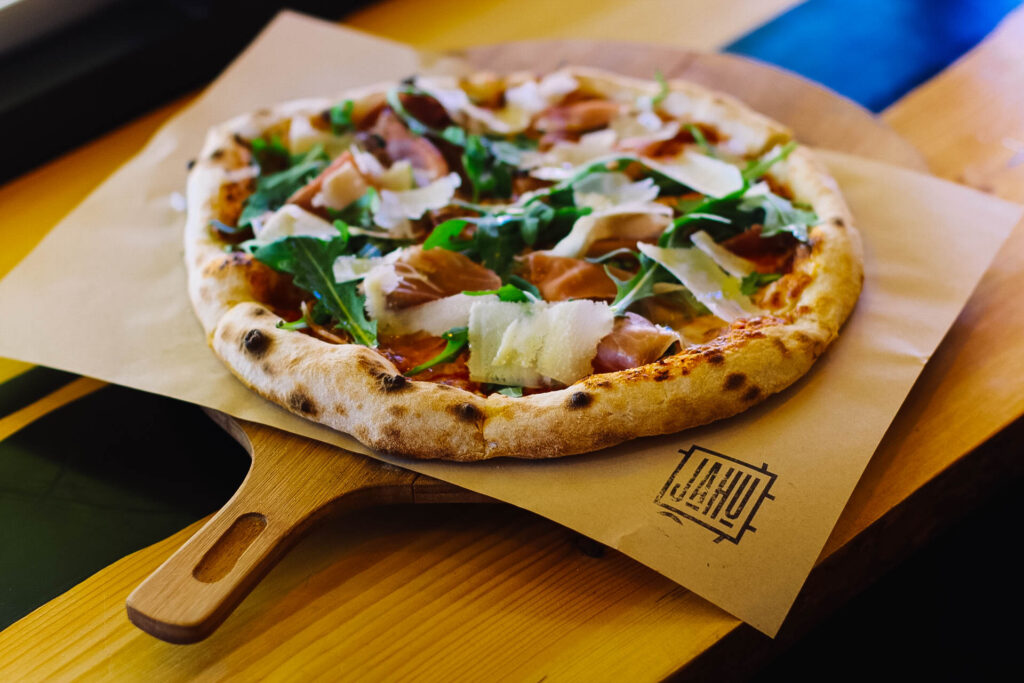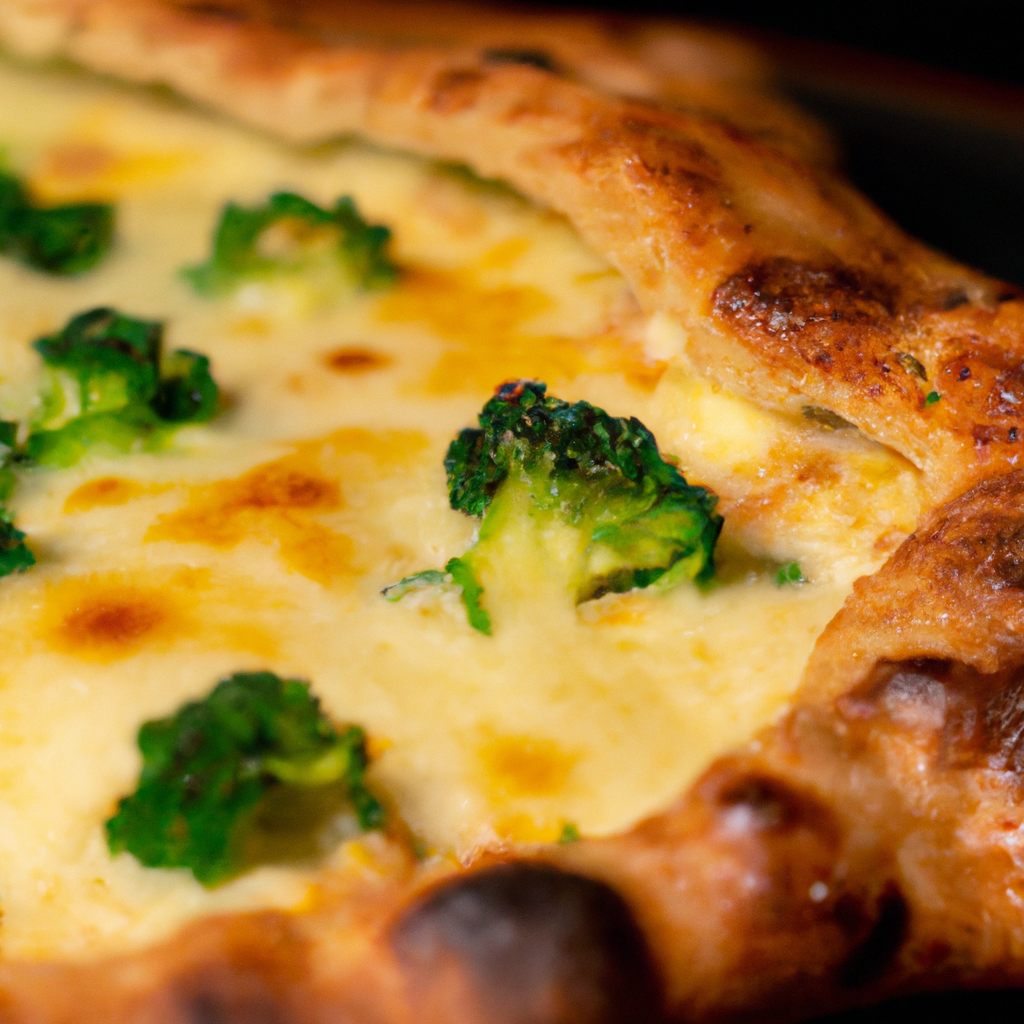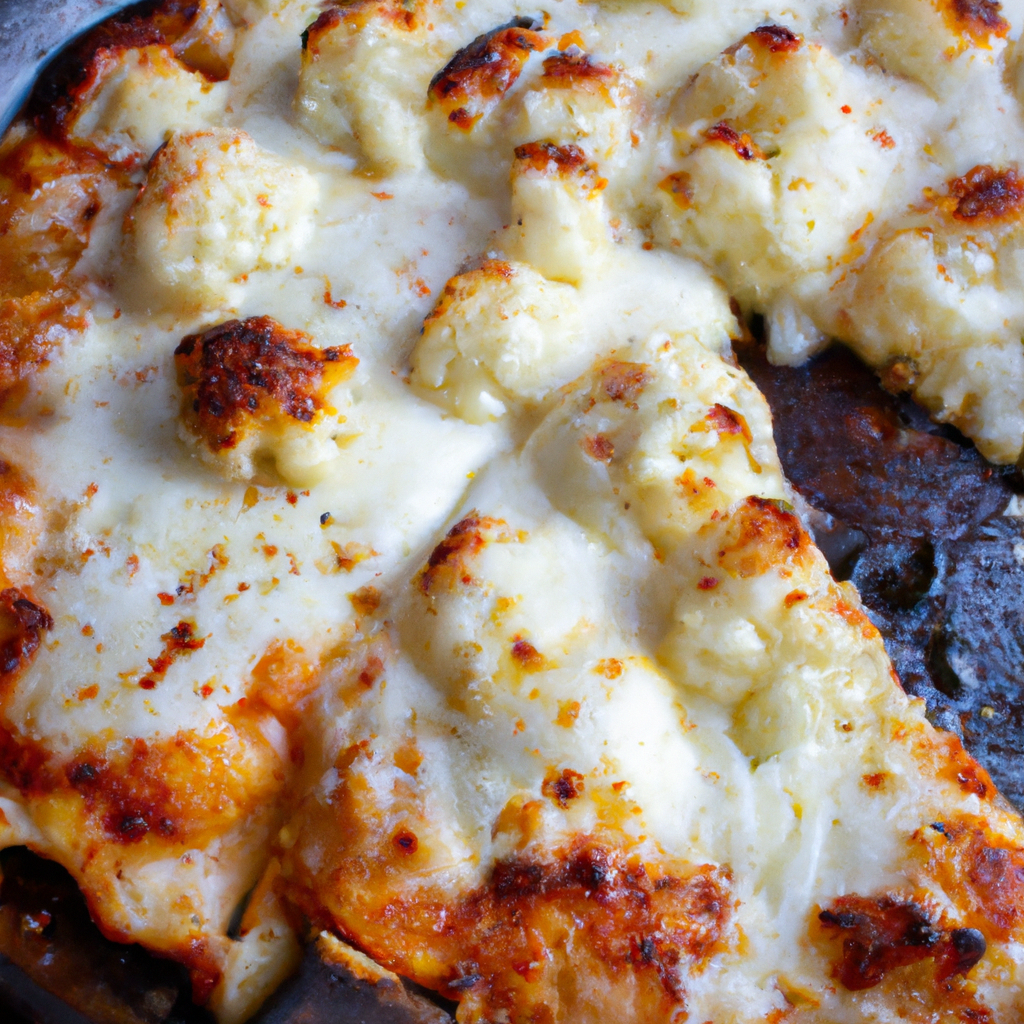Are you craving pizza but trying to watch your carb intake? Look no further! In this article, we will show you how to create a delicious low-carb pizza crust using cauliflower as the main ingredient. Cauliflower is a versatile vegetable that can be transformed into a flavorful and nutritious substitute for traditional pizza crust. With just a few simple ingredients and some creativity, you’ll be enjoying a guilt-free slice of pizza in no time. So, let’s get cooking and discover the secret to a healthy and satisfying pizza crust that will leave you wanting more.

Choosing the Right Ingredients
Fresh Cauliflower
When making a low-carb pizza crust using cauliflower, it is crucial to start with fresh cauliflower. Look for heads of cauliflower that have a vibrant white color, firm texture, and tight florets. Avoid cauliflower heads that have brown spots or feel soft to the touch. Opting for organic cauliflower can also ensure that you are using a high-quality ingredient that is free from harmful pesticides.
Other Ingredients
In addition to fresh cauliflower, there are a few other basic ingredients that you will need for your low-carb pizza crust. These include eggs, cheese (such as mozzarella or Parmesan), and a binding agent such as almond flour or coconut flour. Depending on your preferences and dietary restrictions, you can also add various spices, herbs, and other flavorings to enhance the taste of your crust.
Optional Additions
While the basic ingredients listed above are essential for making a delicious low-carb cauliflower pizza crust, there are also some optional additions that you can consider. For instance, if you enjoy a herby flavor, you can add finely chopped basil or oregano to your crust mixture. Additionally, if you want to add a touch of heat, you can incorporate a pinch of red pepper flakes. Feel free to experiment and get creative with your crust by adding ingredients that suit your taste.
Preparing the Cauliflower
Washing and Drying
Before you begin preparing your cauliflower crust, it is essential to wash the cauliflower thoroughly. Rinse the head of cauliflower under cool running water, making sure to remove any dirt or debris that may be present. After washing, pat it dry using a clean kitchen towel or paper towels. Ensuring that your cauliflower is clean and dry will help achieve the desired texture and consistency for your crust.
Cutting and Ricing
Once your cauliflower is clean and dry, it’s time to cut and rice it. Start by removing the leaves and stem from the cauliflower head, then cut it into small florets. You can then process the florets in a food processor until they resemble rice-like grains. Alternatively, you can use a box grater or a knife to achieve a similar texture. The goal is to break down the cauliflower into fine pieces that will blend seamlessly into the crust mixture.
Steaming or Microwaving
Next, you will need to cook the riced cauliflower to soften it and remove excess moisture. There are two primary methods for achieving this: steaming or microwaving. Steaming involves placing the cauliflower in a steamer basket over boiling water and cooking for about 5-6 minutes until tender. If you prefer a quicker method, you can microwave the cauliflower in a covered microwave-safe bowl for approximately 4-5 minutes. Both methods work well, so choose the one that is most convenient for you.
Removal of Excess Moisture
Using a Cheesecloth
One crucial step in making a low-carb cauliflower pizza crust is removing excess moisture from the cooked cauliflower. Excess moisture can cause the crust to become soggy, so it’s essential to eliminate it as much as possible. One effective method for doing this is by using a cheesecloth. Place the cooked cauliflower in a cheesecloth and squeeze out the excess moisture. You will be amazed at how much liquid can be extracted, leading to a crispier crust.
Using a Nut Milk Bag
Alternatively, if you don’t have a cheesecloth on hand, you can use a nut milk bag to remove the excess moisture. Simply transfer the cooked cauliflower into the bag, close it tightly, and squeeze out the liquid. Nut milk bags are designed to strain liquids from nuts and seeds, making them an excellent tool for removing moisture from the cauliflower.
Using a Fine-Mesh Strainer
If you don’t have a cheesecloth or a nut milk bag, don’t worry! A fine-mesh strainer can also do the job effectively. Place the cooked cauliflower into the strainer and press it against the sides using a spoon or spatula. This will help extract any remaining liquid and leave you with a drier cauliflower mixture for your crust.
Blending and Mixing
Using a Food Processor
To achieve a smooth and well-mixed cauliflower pizza crust, using a food processor is highly recommended. Transfer the cooked cauliflower into the food processor and pulse it a few times until it reaches a rice-like consistency. Then, add the eggs, cheese, binding agent, and any additional spices or herbs. Process the mixture again until all the ingredients are well combined. The food processor will ensure that the crust mixture is thoroughly blended, creating a cohesive and tasty base for your pizza.
Using a Blender
If you don’t have a food processor, a blender can be a suitable alternative for blending and mixing your cauliflower crust. Transfer the cooked cauliflower into the blender and pulse it until it becomes finely riced. Then, add the eggs, cheese, binding agent, and any other desired ingredients. Blend the mixture on a low setting, stopping occasionally to scrape down the sides, until all the ingredients are well incorporated.
Hand Mixing
If you prefer a more hands-on approach, you can mix the crust ingredients by hand. Start by placing the cooked cauliflower in a large bowl and mashing it with a fork or potato masher until it resembles rice. Then, add the eggs, cheese, binding agent, and any desired spices or herbs. Mix everything together using a spoon or your hands until a uniform dough forms. While this method requires more elbow grease, it can still produce excellent results.

Seasoning and Flavors
Adding Spices and Herbs
Once your cauliflower crust mixture is well-combined, it’s time to season it and add some flavor. This is your chance to get creative and tailor the taste of your crust to your preferences. Some popular spices and herbs to consider include garlic powder, onion powder, Italian seasoning, dried basil, or oregano. Sprinkle in your desired seasonings and herbs, keeping in mind the intensity of their flavors. Remember, a little goes a long way, so start with smaller amounts and adjust to taste.
Incorporating Cheese
To enhance the flavor and texture of your low-carb cauliflower pizza crust, consider incorporating some cheese. Cheese can add a delicious, savory element to the crust while also acting as a binding agent. Mozzarella cheese is commonly used in cauliflower crusts but feel free to experiment with other types such as Parmesan or cheddar. Grate or shred the cheese and mix it into the crust mixture, ensuring it is evenly distributed for a cheesy bite in every slice.
Experimenting with Flavors
One of the joys of making your own cauliflower pizza crust is the ability to experiment with different flavors. Don’t be afraid to think outside the box and add unique ingredients that will take your crust to the next level. For example, you could add finely chopped sun-dried tomatoes for a burst of tanginess or incorporate nutritional yeast for a cheesy, umami flavor. The possibilities are endless, so let your taste buds guide you and have fun with the process.
Forming the Pizza Crust
Pressing the Crust
Now that your cauliflower crust mixture is seasoned and full of delicious flavors, it’s time to form it into the shape of a pizza crust. Preheat your oven to the desired temperature (more on that later) and prepare a baking sheet or pizza stone. Place a sheet of parchment paper on the baking surface to prevent the crust from sticking. Scoop the cauliflower mixture onto the parchment paper and use your hands to press and shape it into your desired pizza crust shape – whether it’s round, square, or rectangular.
Baking or Cooking Method
Once the crust is shaped, it’s time to decide on the cooking method. The most common method is baking the crust in the oven, but you can also try grilling or stovetop cooking for a unique twist. Baking the crust at a high temperature will help achieve a crispy texture, while grilling or stovetop cooking can add a smoky flavor. Whichever method you choose, follow the specific instructions provided in your recipe to ensure the crust cooks evenly and to your desired crispness.
Creating Different Sizes
Another benefit of making a cauliflower pizza crust is the versatility to create different sizes depending on your needs. If you’re planning to make individual personal-sized pizzas, divide the cauliflower mixture into smaller sections and shape them accordingly. For larger pizzas, simply adjust the quantity and shape of the crust accordingly. Whether you’re feeding a crowd or enjoying a solo pizza night, you have the freedom to customize the size of your cauliflower pizza crust to suit your appetite.
Pre-Baking the Crust
Using Parchment Paper
To ensure that your cauliflower pizza crust bakes evenly and doesn’t stick to the pan, it’s essential to pre-bake it using parchment paper. The parchment paper acts as a non-stick surface, allowing you to easily remove the crust once it’s cooked. Carefully transfer the shaped crust (still on the parchment paper) onto a baking sheet or pizza stone and place it in the preheated oven. This step sets the foundation for a perfectly cooked and crispy crust.
Greasing the Pan
If you don’t have parchment paper on hand, another method to prevent sticking is greasing the pan. Lightly grease the baking sheet or pizza stone with cooking spray or a drizzle of olive oil. This will create a slick surface for the crust, making it easier to remove once it’s cooked. Just be sure to use a light touch when greasing to avoid adding excess oil, which can affect the final texture of the crust.
Optimizing Crust Texture
Pre-baking the cauliflower pizza crust not only helps prevent sticking but also optimizes the texture of the finished product. The initial baking process allows the crust to firm up, ensuring it can hold up to the weight of your preferred toppings. This step is especially crucial when using moist or heavy ingredients so that your pizza doesn’t become soggy. Pre-baking your crust will help achieve a crispy exterior and a tender, yet sturdy, interior.
Toppings and Sauce
Choosing Low-carb Options
When it comes to topping your low-carb cauliflower pizza crust, it’s essential to choose ingredients that align with your dietary goals. Opt for low-carb options such as fresh vegetables (e.g., bell peppers, mushrooms, spinach), lean proteins (e.g., grilled chicken, lean ground turkey), and flavorful cheeses. Avoid high-carb ingredients like traditional pizza sauces that contain added sugars, as well as starchy toppings like potatoes or corn. Get creative with your toppings and explore fresh, flavorful combinations that will complement the cauliflower crust.
Making Homemade Sauce
If you prefer a traditional pizza sauce, you can make a low-carb version at home. Start by sautéing garlic and onions in olive oil until they become fragrant and slightly golden. Then, add crushed tomatoes, herbs such as basil and oregano, and a touch of salt and pepper. Simmer the sauce for 15-20 minutes to allow the flavors to meld together. Homemade low-carb pizza sauce is a delicious alternative that can elevate the flavors of your cauliflower crust without adding unnecessary carbs.
Creative Topping Combinations
One of the best parts about making your own cauliflower pizza is the ability to experiment with innovative topping combinations. Don’t be afraid to step outside the realm of traditional pizza toppings and explore new flavors and textures. Consider topping your cauliflower crust with ingredients like roasted garlic, caramelized onions, artichoke hearts, or even fresh fruits like sliced peaches or figs for a sweet and savory twist. Let your imagination run wild and create unique, mouthwatering pizzas that will surprise and delight your taste buds.

Baking the Pizza
Proper Temperature and Timing
The proper temperature and timing when baking your cauliflower pizza are crucial to achieving a crispy crust and fully cooked toppings. Preheat your oven according to the specific temperature mentioned in your recipe, usually around 425°F (220°C). Bake the pizza for the recommended time, which typically ranges from 12-15 minutes. Keep an eye on the crust and toppings as they bake, as the cooking time may vary depending on the thickness of the crust and the specific ingredients used.
Checking for Doneness
To determine if your cauliflower pizza is done baking, you’ll want to look for a few key signs. The crust should be golden brown around the edges and slightly firm to the touch. The cheese should be melted and bubbly, and any vegetables or proteins on top should be cooked through. Be cautious not to overbake the pizza, as this can lead to a dry crust. Use your judgment and remove the pizza from the oven when it appears perfectly cooked and ready to be enjoyed.
Achieving a Crispy Crust
To achieve a crispy cauliflower pizza crust, there are a few tips and tricks to keep in mind. Firstly, make sure to remove as much moisture as possible from the cauliflower before baking. Excess moisture can lead to a soggy crust. Additionally, preheating your oven adequately and using a higher temperature can help create a crispy texture. Lastly, placing the pizza directly on a hot pizza stone (if available) can mimic the effect of baking in a brick oven, resulting in a delightfully crispy crust.
Serving and Enjoying
Slicing and Plating
Once your cauliflower pizza is perfectly baked and out of the oven, it’s time to slice and plate it for serving. Use a sharp pizza cutter or a knife to slice the pizza into your desired portions. Whether you prefer traditional triangular slices or fun square-shaped sections, cut the crust with confidence. Carefully transfer each slice onto individual plates or a serving platter, ensuring that each piece maintains its shape and integrity.
Pairing with Sides
To complete the pizza experience, consider pairing your cauliflower pizza with delicious sides. Opt for fresh, crisp salads dressed with a light vinaigrette or a creamy, herb-infused dip for dunking. For a heartier meal, roasted vegetables or a side of protein like grilled chicken or fish can add balance and satisfaction. The possibilities are endless, so choose sides that complement the flavors of your pizza and satisfy your hunger.
Storing and Reheating
If you find yourself with leftovers (which is rare because cauliflower pizza is so delicious), properly storing and reheating your pizza will ensure it remains enjoyable. Allow any leftover pizza to cool completely before transferring it to an airtight container or wrapping it tightly in foil. Store it in the refrigerator for up to 3-4 days. When ready to reheat, preheat your oven to 350°F (175°C) and place the pizza on a baking sheet. Warm it in the oven for about 10 minutes or until heated through. Alternatively, you can reheat individual slices in a toaster oven or microwave for a quick meal.
By following these comprehensive steps, you can create a mouthwatering low-carb pizza crust using cauliflower. Get creative with your flavors, enjoy the process, and savor every delicious bite of your homemade cauliflower pizza. Cheers to a healthier, guilt-free alternative that doesn’t compromise on taste!
